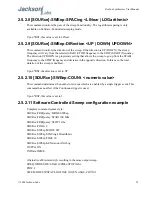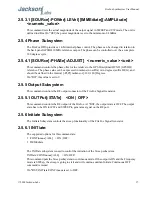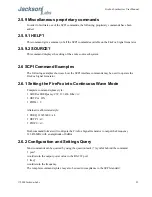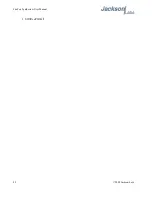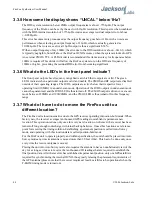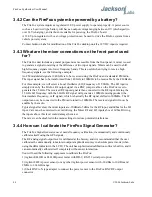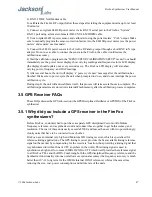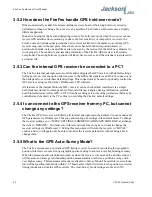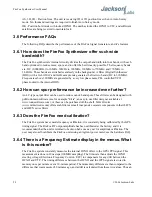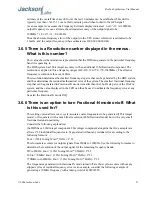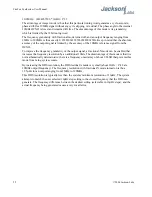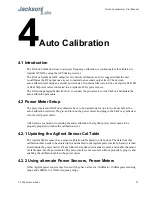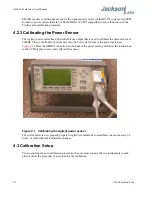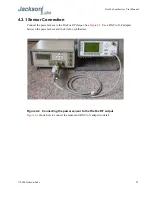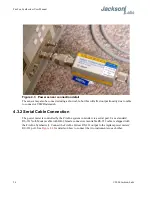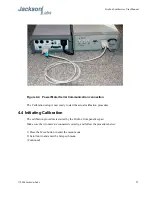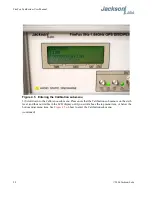
© 2006 Jackson-Labs
43
FireFox Synthesizer User Manual
be used in any digital logic application up to 390MHz, far outperforming competitive solutions
allowing it to be used in SDR, DDR, QDR memory interfaces, or as CPU master clock drivers.
* 50 Ohm AC-coupled spectrally pure RF sine-wave output from 2MHz to 1640MHz. Used in any
type of communication applications that require a low phase-noise, spectrally pure output signal.
Adjustable from typically less than -40dbm to up to +18dbm depending on the frequency (in relative
output mode, when setting 0% to 100% output power).
* LVDS digital differential, 50 Ohm signal on two SMA connectors. Typically terminated by a 100
Ohm resistor between the two signals. This signal is used in modern high-speed interfaces such as
LCD panels, FPGAs, memories etc. These signals can also be used as standard RF signals when
connected via an AC coupler (output at ca. -3 to -5dbm), or as PECL differential signals when
terminated to ground via two 50 Ohm resistors. The signal is being driven from 10MHz to 1640MHz,
with an under-range down to 2MHz.
* BNC connector with a 10MHz very low phase-noise Reference clock output, digital CMOS 3.3V
level. This signal in combination with a CMOS 3.3V level 1PPS output is similar to other frequency
references on the market, and may be used as an in-house frequency standard to drive other
instruments for better than 10^-12 long term performance.
* Broadband 2GHz analog mixer. A general-purpose broadband mixer with over 350MHz bandwidth
is available on the front panel. This can be used in receiver, transmitter, or transponder applications.
Any RF signal up to 2GHz may be mixed with an LO signal up to 2GHz, and produce a 350MHz
bandwidth IF signal. The RF signal input can be driven by a -20dbm to +10dbm signal. The LO input
can typically be driven by the Synthesizers’ own RF-type output (see above) at 0dbm. To avoid
damage, a signal amplitude maximum of +10dbm should not be exceeded on the RF and LO inputs.
3.3.3 Can the FireFox system keypad be locked?
Yes, the FireFox keypad can be locked with jumper JP11 located on the FireFox main PCB.
3.3.4 How come the Frequency Display doesn’t let me select
the exact Frequency I need?
You probably have turned off Fractional-N mode (see also “Resolution” FAQ under Performance
section). With fractional-N mode disabled, the frequency granularity that can be generated is 1/65536
of the granularity when the fractional-N mode is enabled.
A warning message in the LCD display shows “FractOff” to indicate that the fractional-N mode is
turned off.
When the fractional-N mode is turned off, the frequency will still be increased or decreased in 10µHz
steps when pressing the UP/DOWN buttons, but the display will show the actual frequency that can
be generated by the DDS (closest match to the desired frequency) once the button is released.
The advantage of turning off the fractional-N mode is that the system generates an exact
mathematically deterministic frequency without residual, fractional errors that are present in
fractional-N mode.
Summary of Contents for FireFox
Page 1: ...FireFox Synthesizer User Manual Document 0012008 Version 004 Date 10 April 2008...
Page 2: ...FireFox Synthesizer User Manual Copyright 2008 Jackson Labs...
Page 34: ...FireFox Synthesizer User Manual 28 2006 Jackson Labs...
Page 46: ...FireFox Synthesizer User Manual 40 2008 Jackson Labs SOURce POWer...







